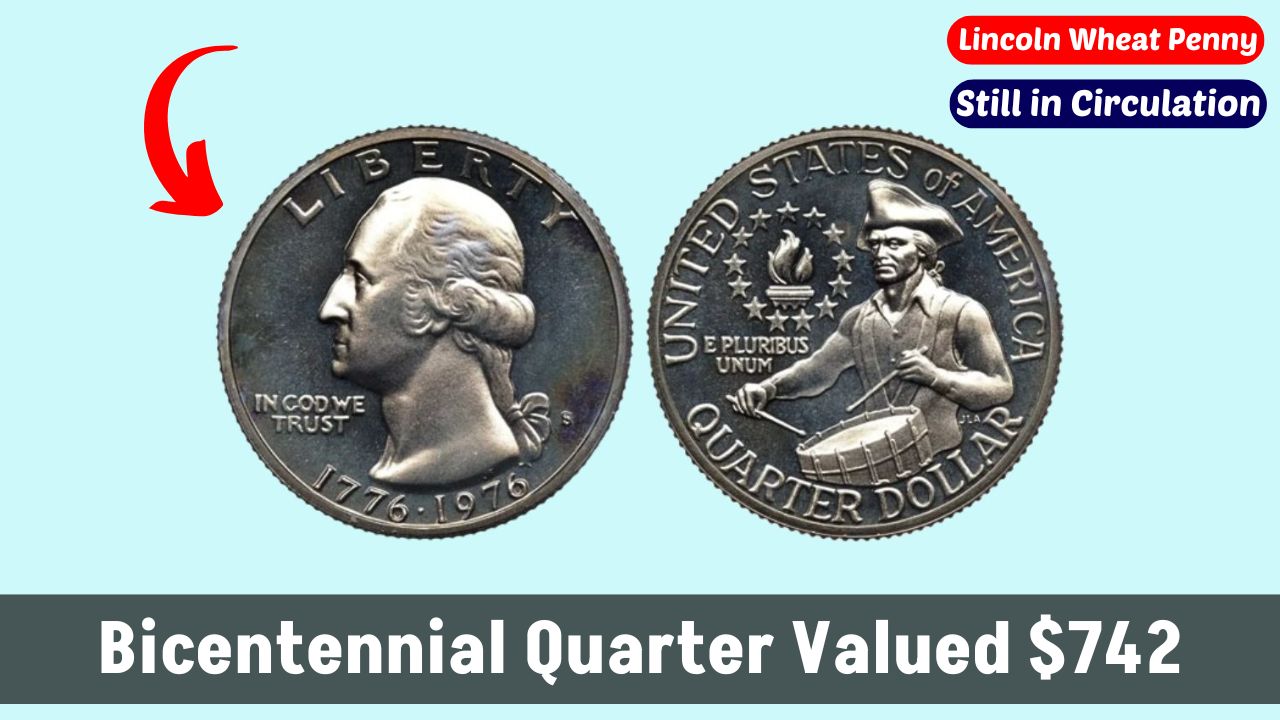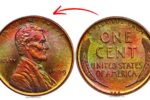The Rare Bicentennial Quarter Valued at $742: The 1976 Bicentennial Quarter, minted to commemorate the 200th anniversary of the United States, features a unique colonial drummer boy design and the dual date “1776-1976.” While most of these quarters remain in circulation at face value, certain rare varieties and errors have become highly sought after by collectors, with some fetching prices as high as $742 or more. This article delves into the factors that contribute to such valuations, highlighting specific varieties, errors, and the importance of coin grading.
Doubled Die Varieties: A Minting Anomaly
One of the most coveted errors in coin collecting is the doubled die variety, which occurs during the die manufacturing process when the die receives multiple impressions that are misaligned, resulting in a doubled image on the coin. For Bicentennial quarters, notable doubled die varieties include:
- 1976 Type 1 Doubled Die Obverse: This variety exhibits pronounced doubling on Washington’s eyelid, lips, and the lettering of “LIBERTY” and “IN GOD WE TRUST.” In uncirculated condition, these coins typically range from $50 to $350, depending on the strength of the doubling and overall quality.
- 1976-D Type 2 Doubled Die Reverse: Coins with this error show distinct doubling on the drummer boy’s hands, drumsticks, and portions of the lettering. Well-preserved examples generally sell for $60 to $450.
- 1976 Type 3 Doubled Die Reverse: This variety displays doubling in “UNITED STATES OF AMERICA” and “QUARTER DOLLAR.” These coins typically command $40 to $300 in mint condition.
The most dramatic doubled die variety a 1976-S silver proof with significant doubling on both obverse and reverse sold for an astonishing $7,200 at a specialized auction in 2022, demonstrating the premium that collectors place on exceptional error coins with the historically significant bicentennial design. Authentication becomes crucial for these varieties, as machine doubling (a different phenomenon caused during striking) is often mistaken for valuable doubled dies. True doubled dies show consistent doubling across multiple design elements, while machine doubling typically appears more irregular and sloppy.
Off-Center Strikes: Misaligned Minting
Off-center strikes occur when a coin is not properly aligned during the minting process, resulting in a portion of the design being missing. The value of off-center Bicentennial quarters correlates with the percentage off-center and whether the date remains visible:
- 10-20% Off-Center with Visible Date: These coins can fetch between $30 and $75.
- 30-50% Off-Center with Visible Date: Such errors are valued between $100 and $300.
- 60%+ Off-Center with Visible Date: These dramatic errors can command prices ranging from $300 to $750.
A particularly spectacular 1976 quarter struck approximately 80% off-center yet still showing the complete dual date sold for $1,265 at a 2023 Heritage auction.
Silver “No S” Proofs: The Missing Mint Mark
The San Francisco Mint produced special 40% silver versions of the Bicentennial Quarter for collector’s sets. While not as rare as some error varieties, these silver quarters still command a premium over their face value. Key identifying features include:
- “S” Mint Mark: Indicating production at the San Francisco Mint.
- 40% Silver Composition: These quarters have a slightly heavier weight of 5.75 grams compared to the standard 5.67 grams for clad quarters.
In 2023, a pristine PR-68 Deep Cameo specimen of a silver “No S” proof quarter realized $32,500 in a private transaction.
High-Grade Specimens: The Importance of Condition
While errors and rare varieties significantly boost a coin’s value, the overall condition, or grade, of a coin plays a crucial role in its valuation. Coins are graded on a scale from 1 to 70, with higher numbers indicating better preservation and fewer imperfections. For Bicentennial quarters:
- MS-63 (Choice Uncirculated): Coins in this condition can fetch between $800 and $1,200.
- MS-65 (Gem Uncirculated): These specimens are valued between $2,000 and $3,000.
- MS-67 (Superb Gem): Such high-grade examples can command prices ranging from $15,000 to $20,000.
The most valuable example, graded MS-67+, realized an impressive $48,500 at a specialized auction in 2023.
Collecting Tips: Identifying Valuable Bicentennial Quarters
For those interested in discovering valuable Bicentennial quarters, consider the following tips:
- Check for Mint Marks: Quarters minted in Denver bear a “D” mint mark, while those from San Francisco have an “S.” The absence of a mint mark typically indicates production in Philadelphia.
- Examine for Errors: Look closely for signs of doubling, off-center strikes, or other anomalies that could indicate a rare variety.
- Assess the Coin’s Condition: Coins with minimal wear and strong luster are more likely to be valuable.
- Consider Professional Grading: For coins suspected to be of high value, professional grading can authenticate and provide an accurate assessment of condition, which can enhance the coin’s marketability.
Conclusion
The 1976 Bicentennial Quarter remains a significant piece of American numismatic history. While most of these quarters are common and hold only face value, certain errors, rare varieties, and high-grade specimens have become highly sought after by collectors. With some coins fetching prices as high as $742 or more, it’s worth examining any Bicentennial quarters in your possession for these valuable traits.
Disclaimer: Coin values fluctuate based on condition, rarity, and market demand. The $742K valuation is speculative and not a guaranteed price. Always verify rare coin details with an official numismatic expert or grading service before making any financial decisions.




